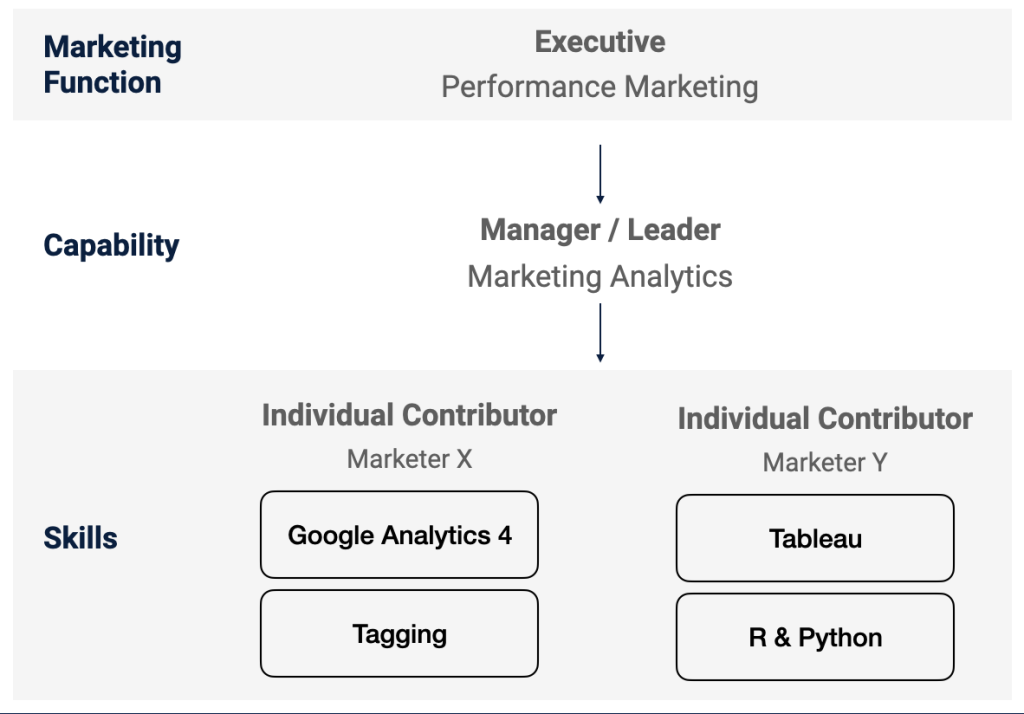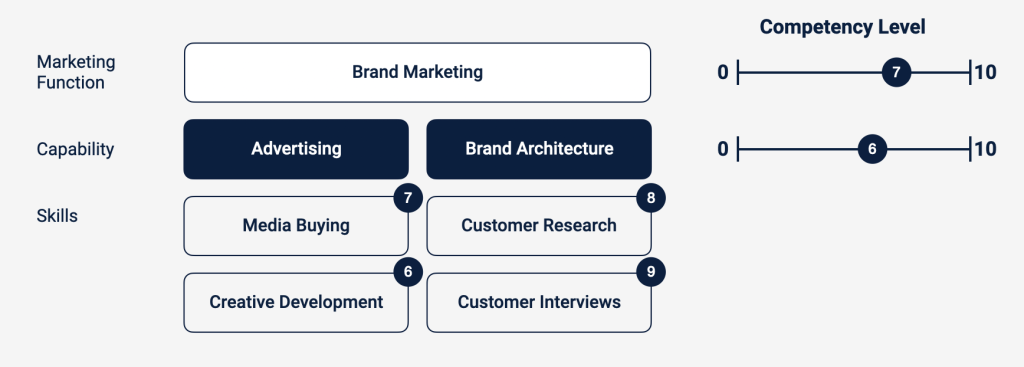Developing Marketing skills & capabilities
By Martijn Scheijbeler Published June 29, 2023Everyone in their career focuses on learning the latest tools or technologies. These rarely change the game as they’re “just” skills. TikTok or Prompt Engineering are platforms and skills but aren’t necessarily capabilities you can be competent in. In the example you just read, understanding TikTok as a platform and the content there helps build the capability of (social) content creation and social advertising. Prompt engineering as a skillset could eventually lead to building out scaling content production (either visual or written) through AI. That’s where progress starts, and this doesn’t mean skills aren’t necessary.
For years, we’ve also talked about the T-Shaped Marketer [1], a fantastic concept that is certainly standing the test of time. It plays a vital role in developing marketing skills to help boost the organization’s effectiveness in building capabilities.
“You grow into being a marketing leader and the T becomes more about the domains: you might be deep in growth, but you have to understand brand or product marketing… But then you grow to become an executive, and marketing becomes the T; you’re deep into that. But you also need to be versed in finance and product, and it’s a journey. Great marketers get curious about that; you get good at hiring to enable this.”
– Joanna Lord on the Marketing Against the Grain podcast
Transitioning from Individual Contributor to Manager to Executive
While you’re transitioning from an individual contributor to a manager/leader, and from there potentially to an executive, the thinking about skillsets changes as it becomes about building capabilities. You want to consider the skills a function needs and the required competence level. Are you going to in-house this or outsource (agency, contractor, etc.)?

My Personal Story: From Marketer to Leader/Manager to Executive; A Skill Isn’t Just a Function
In my early days as a marketer, I was concerned with learning about Google Ads, Moz, how to create print ads or the latest link-building tactics. These skills served me well over the years as they provided foundational knowledge to help build capabilities and understand what people were discussing. However, they were not aimed at building the capability of paid acquisition or SEO for a whole team or organization. I was in execution mode, rather than strategy mode.
When I started managing people, it became about building an engine for experimentation, developing a marketing analytics capability, or being able to run paid acquisition across multiple brands. As this was building upon my existing skillset, it was easier to develop a capability.
As I became an executive, it became much more important to think about what marketing functions we needed as a marketing organization and how to develop those best so that we had the right capabilities and skillsets in place (this often does not just require hiring people).
Answering the question: What do you really want to be good at?

Companies across sectors often announce technological or digital elements in their strategies without necessarily having the right capabilities in place to integrate them.
In a 2020 McKinsey survey of more than 860 executives, 78% said capability building was very or extremely important to their organizations’ long-term growth (versus 59% of leaders who said so before the global COVID-19 pandemic).2 And more than half of surveyed leaders (53%) ranked capability building as the most useful way to close skill gaps.
– McKinsey – State of Organizations publication
As leaders, we need to determine what capabilities to get the job done and close the capability gap. For this, I see two approaches:
- Bottoms-up approach: If you come into an existing organization, it’s much more about figuring out what skills already exist to identify the gaps you need to fill.
- Top-down approach: If you’re building an organization from scratch or have existing insight into people’s skill sets, you can leverage this as the starting point to figure out how to tackle the job to be done and hire for the functions you might require in the future.
Adapting Talent Management
“We have to learn how to create athletes that go across the specialities in Marketing… we built our teams on specialization but it requires a broad perspective on Marketing, Business and a set of skills that is needed. We will have to adapt talent management strategies to help build athletes that have the capabilities to be the succesful CMOs in the future.“
– Michael Roberts, MetLife CMO at the Spencer Stuart CMO Summit 2022
This ties directly to the first quote about expanding yourself as marketing while going through the different seniority levels. Different skills are needed today than when I started as a marketer, and specific skills have increased in importance or didn’t even exist. Addressing this with your teams, and providing them with the tools (a future blog post) to increase their competency level is essential.
→ In Modern Marketing: Six capabilities for multidisciplinary teams, the McKinsey team also found that many organizations lack capabilities. This could range from a technology stack that isn’t up to date or the lack of ability to act upon the data available to us as marketers.
Outsource, Hire or Learn; getting better at social media

Five years ago at RVshare, three people shared social media responsibility. We decided to hire one person for the role and centralize our efforts. Later, we added another person to the team. We realized we needed external help for visualization and video creation, so we found an agency to complement us and improve the function. This function is constantly evolving with new platforms and required skills.
There is a lot more context on this topic, so I might expand this into a series in which I’ll also talk about the tactical setup of building skills & capabilities.